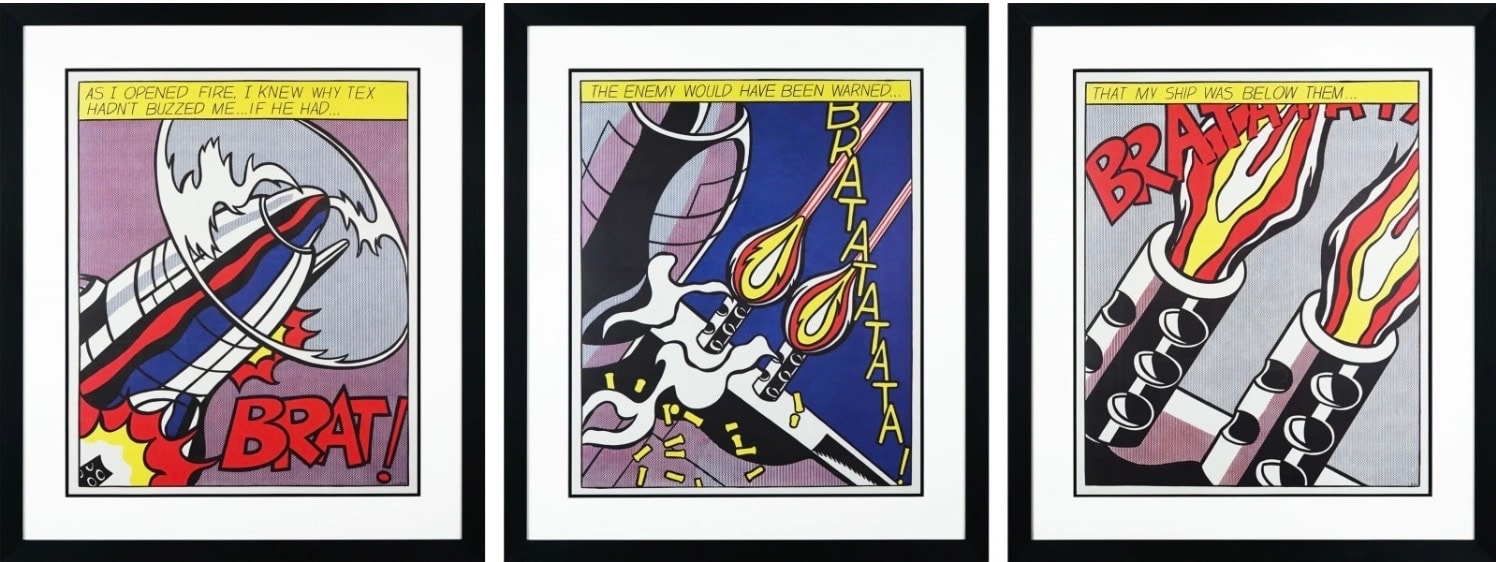Roy Lichtenstein American, 1923-1997
64 x 52 cm
Roy Lichtenstein (1923-1997)
As I opened fire (Triptych), 1966
Three Offset Lithographs in colour on wove paper
Published by Stedelijk Museum, Amsterdam as a reproduction of the painting by the same name from their collection
Hand signed in pencil lower right, from an edition of 3000
Sheet: 63x53cm each
Provenance Private Collection, U.K.
Condition: Excellent
The present work, titled "As I Opened Fire," is inspired by a 1964 oil and magna canvas housed at the Stedelijk Museum in Amsterdam. It is based on a reimagined sequence from a comic book by Jerry Grandenetti in DC Comics, where Lichtenstein altered the panels to create a seamless cinematic effect. The artwork captures three brief moments in an aerial combat scene, connected by onomatopoeic words representing the sounds of battle, implying a continuous narrative flow. The absence of clear distinctions between friend and foe reflects the chaotic nature of war.
Lichtenstein was drawn to the emotionally charged yet impersonal portrayal of war found in comic books. He aimed to give his paintings a machine-like quality, devoid of human touch, despite being meticulously painted by hand. The artist intended for his war-themed artworks to satirize military aggression, highlighting the absurdity of conflict. While acknowledging the terrifying aspects of foreign policy, Lichtenstein emphasized that his art focuses on American visual culture and communication rather than political commentary
By incorporating elements of mass culture and consumerism into his art, Lichtenstein and his contemporaries challenged the conventions of traditional art and brought a new perspective to the art world. His innovative approach to blending high and low culture continues to influence artists and audiences to this day.
Provenance
Roy Lichtenstein (1923-1997)
As I opened fire (Triptych), 1966
Three Offset Lithographs in colour on wove paper
Published by Stedelijk Museum, Amsterdam as a reproduction of the painting by the same name from their collection
Hand signed in pencil lower right, from an edition of 3000
Sheet: 63x53cm each
Provenance Private Collection, U.K.
Condition: Excellent
Roy Lichtenstein was a key figure in the American Pop Art movement, which emerged in the US alongside artists like Jasper Johns, James Rosenquist, Claes Oldenburg, and Andy Warhol. He developed a distinctive and iconic style that incorporated imagery from advertisements, comics, and everyday life, aiming to replicate the mechanical and commercial look of printed materials through meticulous rendering of Ben-Day dots using paint and stencils. Lichtenstein’s cartoon aesthetic turned him into a household name.
The Pop Art movement challenged traditional subject matter and artistic approaches by drawing inspiration from popular culture and mass media. Through the use of easily recognizable imagery from everyday life, Pop Art blurred the boundaries between "high" and "low" art, marking a significant shift in the trajectory of modernism.
The present work, titled "As I Opened Fire," is inspired by a 1964 oil and magna canvas housed at the Stedelijk Museum in Amsterdam. It is based on a reimagined sequence from a comic book by Jerry Grandenetti in DC Comics, where Lichtenstein altered the panels to create a seamless cinematic effect. The artwork captures three brief moments in an aerial combat scene, connected by onomatopoeic words representing the sounds of battle, implying a continuous narrative flow. The absence of clear distinctions between friend and foe reflects the chaotic nature of war.
Lichtenstein was drawn to the emotionally charged yet impersonal portrayal of war found in comic books. He aimed to give his paintings a machine-like quality, devoid of human touch, despite being meticulously painted by hand. The artist intended for his war-themed artworks to satirize military aggression, highlighting the absurdity of conflict. While acknowledging the terrifying aspects of foreign policy, Lichtenstein emphasized that his art focuses on American visual culture and communication rather than political commentary
By incorporating elements of mass culture and consumerism into his art, Lichtenstein and his contemporaries challenged the conventions of traditional art and brought a new perspective to the art world. His innovative approach to blending high and low culture continues to influence artists and audiences to this day.
